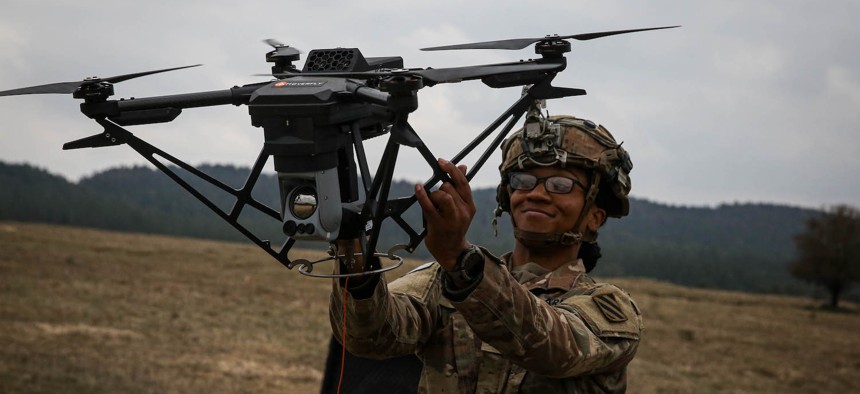
U.S. Army Sgt. Claudia Kinney, assigned to the 6th Squadron, 8th Cavalry Regiment, retrieves a drone during Allied Spirit 24 at the Hohenfels Training Area, Joint Multinational Readiness Center, Germany, March 6, 2024. U.S. Army / Spc. Micah Wilson
Army puts drones front and center in unfunded wishlist
List includes commercial drones for infantry units, plus more counter-drone gear.
What do Army leaders want—but not quite enough to include in their formal 2025 budget request? Aerial drones, counter-drone tech, and ground robots for smaller units, according to the service’s “unfunded priorities” list, obtained by Defense One Friday.
Service leaders have repeatedly said they aim to put more experimental technology in the hands of units for testing, so it’s no surprise that the list includes $10 million for small drones for companies and $25 million for the acquisition of commercially available drones for infantry brigade combat teams.
Army Chief of Staff Gen. Randy George has made acquisition of commercial drones a particular priority, with news of the cancellation of the Future Attack Reconnaissance Aircraft accompanied by the announcement that the Army was phasing out existing drones in favor of commercial ones.
Talking with soldiers at a recent training event, George said troops were eager to get more small drones into their units.
“Most of the complaints [related to drones] were, how can I have this right now?” George said during an interview with Defense One for the State of Defense. Training for some of the drones can take as little as a day, he added.
“We're going to see robotics inside the formation, on the ground and in the air,” George said.
The Army can currently buy commercial drones off of the Blue UAS list, a list of drones vetted for government use. Such drones, however, can be eight to 14 times more expensive than those sold by Chinese companies, the Financial Times reported in 2021.
The Army is hoping that increasing demand will drive down cost, though, said George. “I think once we start to show a demand for more of these, and people are producing them, the prices will continue to come down,” the general said during the State of Defense event.
The Army also hopes to push extra cash toward its program to field one-way attack drones to infantry, dubbed the Low Altitude Stalking and Strike Ordnance, or LASSO, program. The list includes $10 million for LASSO.
Doug Bush, assistant Army secretary for acquisition, told Defense One at AUSA that the Army had ordered more than 100 Switchblade 600s for testing under the LASSO program. The Army budget request for fiscal year 2025 includes a request for $120 million worth of LASSO program drones.
The unfunded list also includes $26.5 million for Short Range Reconnaissance and $34 million for Medium Range Reconnaissance programs. Dronemaker Skydio entered the final phase of testing in the Army’s Short Range Reconnaissance program in January.
The list includes $449 million for counter-drone capabilities for force protection and $292 million for short- to long-range air defense amid frequent drone attacks on U.S. forces in the Middle East and the rise in drone warfare in Ukraine.
Half of the counter-drone capabilities, worth $185 million, are for interceptors. These interceptors may be Raytheon’s Coyote drone interceptors, which the Army has praised as effective in destroying the drones that regularly attack military bases in the Middle East.
The base budget for fiscal year 2025 calls for $117 million in Coyote interceptors, which can cost $125,000 per unit.
Other counter-drone sections under the list’s force protection category include $4.5 million in research and development for Anduril’s Roadrunner-M drone interceptor. It also includes $91 million for anti-air Stinger missiles and $10 million for a previously unidentified program called the “Family of Counter-sUAS system” or FoCUS.
The list also includes a further $84 million in funding for the Joint Counter Small Unmanned Systems University, which teaches soldiers to use hand-held counter-drone jammers and other counter drone devices.
The list also pressed forward with Army plans to bring more robotics into Army units, with $55.5 million requested for human machine integration, a category that includes using robotic, gun-toting vehicles to make first contact with enemy forces. A separate category requests $69.5 million for human machine integration experimentation with the Next Generation Combat Vehicle program.
Earlier in March, soldiers in an Army robotics and autonomous systems platoon in the 82nd Airborne division demonstrated attacking an enemy-held town with a mix of drones and robots at the Army’s Fort Irwin National Training Center.
A separate line calls for $16 million for the Silent Tactical Energy Dismount (STEED), a robot used to carry equipment and evacuate casualties.
Amid increasing use among Starlink and other low earth satellite orbit systems in Army units, the proposed budget also requests $4 million for “proliferated low earth orbit” in the tactical network category.
Other items on the list include $98 million for Precision Strike Missiles (PRSM) and $138 million for Patriot Advanced Capability Three (PAC-3) missiles.


